- NEW DVD Series – Stone Setting with Bezels
- Tube Set Charm by Kim St. Jean
- Prong Basket Pendant by Kim St. Jean
- NEW DVD Series – Stone Setting with Cold Connections
- New DVD Series – Stone Setting with Wire
- NEW DVD Series: Introduction to Stone Setting by Kim St. Jean
- Featured Tool: Bracelet Bending Plier
- NEW Dvd by Eva Sherman
- Fun, Fast Fold Forming DVD Series
- Double Band Ear Cuff from Alex Simkin
Gem Profile July 15: Sunstone
Daily Wire Jewelry Making Tip for
July 15, 2011

Sunstone
one of a series on Feldspar
Today’s profile on Sunstone is the last in this series on Feldspar. Did you miss any of the Feldspars that we covered? Here they are again: Amazonite, Labradorite, Moonstone, Sunstone.
Sunstone Facts
Sunstone is a type of feldspar that belongs to the plagioclase series. Like most other plagioclase crystals, for years, good specimens of sunstone were rare. However, due to large deposits found in eastern Oregon, including fine gem-grade sunstone (it became Oregon’s official gemstone in 1987), sunstone is now available on a more commercial level. Sunstone is often confused with other plagioclase feldspars, such as labradorite and albite, because they are similar in specific gravity, as well as the fact that they are all made from varying amounts of the same elements. These mineral composites create rock formations, and any rock formation that has extremely smooth cleavage at the surface and is too hard to scratch with a knife or other sharp object could very well contain sunstone or one of the other plagioclase feldspars. The largest and most stable crystals, which are found in granite veins in Norway, are generally combined with calcite, quartz, epidote, and orthoclase.

Confetti Sunstone, cut and polished, then wrapped with 22-gauge sterling silver square wire and accented with a CZ snapset, by Beba Adams
Sunstone’s name seems to have come from the bright flashes of light it can throw, or perhaps its color, which resembles the setting sun. Sunstone is sometimes called aventurine feldspar, because it can have the appearance of aventurine, as well as have a reflective effect like schiller, specifically called aventurescence. This type of sunstone is oligoclase, while some sunstone is orthoclase. Oligoclase sunstone is also called heliolite, literally "sun stone" in Greek; this specific type of sunstone, sometimes called confetti stone, can have a mass of glittering hematite particles in it (see picture).
Oligoclase was given its name in 1826 by August Breithaupt, a German mineralogist and professor at Freiberg Mining Academy who succeeded Friedrich Mohs (from whom we get the well-known Mohs scale). The name comes from the Greek oligos, meaning “little,” and clasei, meaning “to break” because it can be extremely brittle and has a less perfect cleavage than albite. Oligoclase ranges from a 6 to a 6.5 on the Mohs scale, has a specific gravity of 2.6, and is made of tabular crystals of hematite and goethite that are twinned, meaning that it is made up of two or more components that are reversed in relation to one another but exist in the same plane. These reversals can occur due to sporadic magnetic reversals of the Earth’s poles.
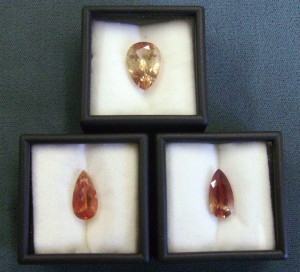
Faceted sunstone mined and cut by Bob Bleily, all from Oregon, USA. Private collection, Dale Armstrong.
Sunstone Sources and Appearance
Sunstone is mainly found in India, the United States, Canada, Norway, China, and Russia. Oligoclase is clear for the most part and white in appearance, almost glass-like, but occasionally, when it is closer in form to a gemstone, it will have a slight bluish sheen. These oligoclase formations that range from translucent to pale blue in color can be found in North Carolina and Tanzania. Crystals that are found in weathered marble can be found in St. Lawrence County, New York. Sunstone is also found in Millard County, Utah. Some oligoclase contains hematite (iron oxide) inclusions, which cause sunstone to brilliantly reflect the sun’s light.When a sunstone is cut as a cabochon, a reddish, sparkling, sun-like appearance occurs. When it is found to be colorless and translucent in its natural form (such as the variety of oligoclase found in North Carolina), it is faceted as a gemstone. This can sometimes be confused with moonstone when it is white due to its luminescent glow. Oregon Sunstone is the only kind of sunstone which contains miniscule copper flecks, which cause the stones to range from clear to red and pink to even green – some stones even changing color in different light, like alexandrite.

Sunstone wrapped with 21-gauge square sterling silver wire and Swarovski® accents by Deborah Hamilton
Sunstone in Culture
In contrast to moonstone, which in 11th century Europe was believed to bring about reunification of lovers, sunstone is thought to be representative of wellness, physical energy, vigor, and valor. The ancient Greeks believed that sunstone represented a means to protect the Earth and keep the Sun on its correct course. Sunstone was also found in an 18th century excavation of an Aztec calendar, as well as being mentioned in medieval Icelandic texts to reveal the position of the sun in overcast skies (although this might have been a reference to a generic "sun stone," not a specific gem). Sunstone has also been used by crystal healers to clear the chakras and promote wellness and peace of mind. A common manmade imitation of sunstone is goldstone, which is a glass gemstone simulant that possesses the same glittery, aventurescent effect as sunstone.
In next week’s gem profile, we’ll cover Rhodochrosite. Have you wire wrapped rhodochrosite before? Send pictures to tips@wire-sculpture.com and they could be featured!
Resources
Print Resources:
- Eyewitness Handbooks’ Rocks and Minerals by Chris Pellant, ISBN 1-56458-033-4
- Peterson Field Guide to Rocks and Minerals by Frederick H. Pough, ISBN-0-395-91096-X
- Smithsonian Rock and Gem by Ronald Louis Bonewitz, ISBN 0-7566-0962-3
Internet Resources:
Gem Profile by Wire-Sculpture Staff member Liza Roberts
| Find Sunstone on Wire-Sculpture.com | |
|---|---|
 |
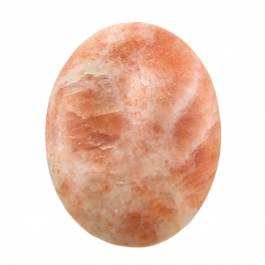 |
| Shop Sunstone Beads | Shop Sunstone Cabochons |
Click to Receive Daily Tips by Email








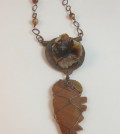




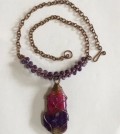


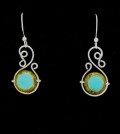




chris murphy
July 15, 2011 at 8:42 am
Thank you for doing these stone features. I have learned so much from reading about my favorite stones and I really am enjoying your series.
Pingback: Gem Profile March 2: About Aventurine | Jewelry Making Blog | Information | Education | Videos